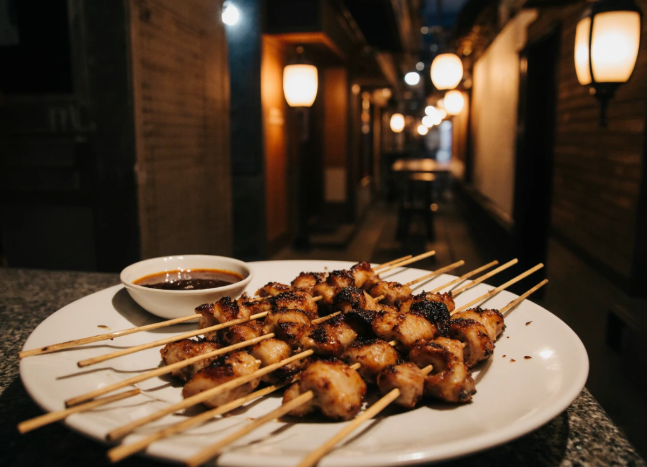Pontocho is a narrow alley running parallel to the Kamogawa River where you’ll find some of Kyoto’s best yakitori tucked into traditional wooden machiya buildings. This 500-meter lane transforms each evening into a dining destination where grilled chicken skewers, cold beer, and intimate atmospheres combine into something distinctly Kyoto.
More about Pontocho:
- Pontocho Park Guided Tours
- The Complete Guide to Pontocho: Kyoto’s Most Atmospheric Alley
- Pontocho Restaurants: Complete Dining Guide
What Makes Pontocho Yakitori Different?
Pontocho Yakitori stands apart because of its setting and preparation style. The establishments here use binchotan charcoal—a dense white charcoal that burns at consistent high temperatures without smoke or odor. This means the chicken gets a crisp exterior while staying tender inside, with none of that acrid taste you get from cheaper fuels.
The chefs work behind small counters, grilling each skewer to order. You watch the process: the chef brushes tare sauce (a sweet-salty glaze made from soy sauce, mirin, and sake) onto the chicken, rotates it over the coals, waits for the exact moment when the sugars caramalize but don’t burn. It takes years to master this timing.
Understanding the types of Yakitori meat is essential for ordering. A proper menu includes:
- Momo (thigh meat) – the most popular cut, with fat that renders as it cooks
- Negima (chicken and leek) – the leek absorbs chicken fat and becomes sweet
- Tsukune (chicken meatballs) – ground chicken mixed with cartilage for texture
- Kawa (chicken skin) – becomes crispy like bacon
- Hatsu (heart) – chewy and iron-rich
- Bonjiri (tail) – the fattiest, most flavorful part
Each venue specializes in different cuts. Some focus on offal. Others perfect the basics.
From Postwar Food Stalls to Dining Destination
Pontocho existed for centuries as a geisha district, but yakitori as we know it only became popular after World War II. Food was scarce. Chicken parts that wealthy families discarded—organs, skin, cartilage—became street food for workers.
Small grills appeared throughout Pontocho. Vendors skewered whatever chicken parts they could source and sold them to laborers and taxi drivers. The food was cheap, filling, and could be eaten standing up.
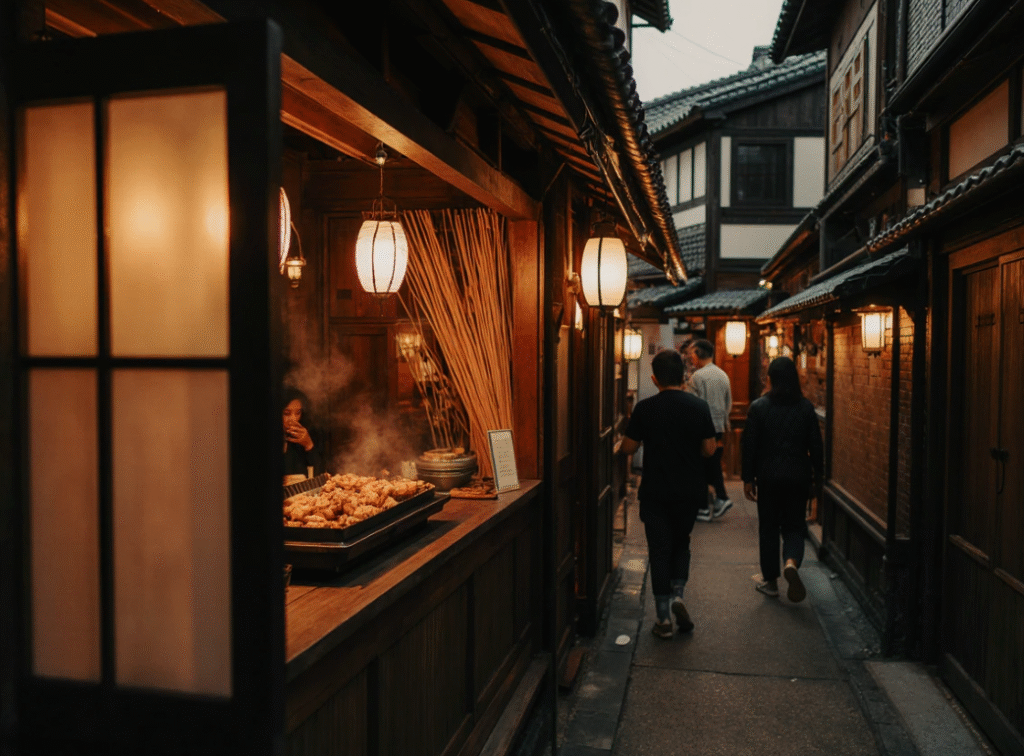
Authentic Pontocho Yakitori Restaurant in Kyoto – Best Yakitori Pontocho Experience
By the 1970s, some of these stalls had become permanent dining spots. The economic boom meant better ingredients. Chefs started refining techniques. What began as survival food evolved into craft.
Pontocho could have gone the same route as nearby Gion—becoming a tourist district with high prices and mediocre food. It didn’t, largely because the narrow alley can’t accommodate tour buses. The venues stayed small. Many remained family-run. The quality survived because the economics stayed local.
Where to Find the Best Yakitori Pontocho
- Yakitori Kazu sits midway down the alley. The counter seats seven people. Chef Kazu sources his chicken from a single farm in Shiga Prefecture and receives the birds within 24 hours of slaughter. His tsukune includes minced cartilage that gives each bite a slight crunch. Expect to pay ¥4,000-6,000 ($27-40) per person. No reservations. Show up at 5:30 PM when they open or wait 90 minutes.
- Torito specializes in rare cuts. They serve sasami (breast tenderloin) with wasabi and bonjiri that’s been aged for two days to concentrate the flavor. The chef speaks enough English to explain each skewer. Yakitori reservations Pontocho are recommended through your hotel for this spot. Budget ¥5,000-7,000 ($33-47) per person.
- Pontocho Robata isn’t exclusively yakitori—they grill vegetables, fish, and beef too—but their chicken liver is the best I’ve had in Kyoto. They soak it in milk first to remove any bitterness, then grill it until the outside firms up but the inside stays creamy. Less specialized than the yakitori-only spots, but good for groups with mixed preferences. ¥3,500-5,000 ($23-33) per person.
According to the Japan National Tourism Organization, Pontocho represents one of Kyoto’s five traditional hanamachi (geisha districts), and its dining culture remains closely tied to this heritage.
“Order omakase (chef’s choice) instead of selecting individual skewers. The chef will start with lighter flavors—breast meat with salt—then progress to richer cuts like thigh and liver with tare sauce. You’ll taste the full range of textures and seasonings in the right sequence. It costs the same but the experience is better.”
Three Common Mistakes (And Their Cost)
Mistake 1: Going during peak dinner hours (7-9 PM)
Tourists read that Pontocho is beautiful at night and arrive at 8 PM expecting to walk in. Every venue has a line. The narrow alley gets crowded. You’ll wait an hour minimum, often standing in the cold with no place to sit.
The cost: You waste 60-90 minutes of your evening, get frustrated, and potentially give up to find food elsewhere. If you have limited time in Kyoto, that’s an entire evening activity lost. For a 4-day trip to Kyoto, losing one evening represents 25% of your dining opportunities.
Better approach: Arrive at 5:30-6 PM when places open. Most yakitori spots start their charcoal around 5:00 PM. Early arrival means no wait, better service (the chef isn’t overwhelmed), and you still have time for other activities afterward.
Mistake 2: Not bringing cash
Many grilled skewer restaurants in Kyoto don’t accept cards. The economics of small establishments with tight margins means credit card fees eat into profits. Some places added card readers during COVID, but plenty haven’t.
The cost: You find a spot, wait for a table, sit down, eat, then discover they only take cash. The nearest ATM is a 10-minute walk. You’re embarrassed. The staff is frustrated. Your dinner ends awkwardly.
Better approach: Withdraw ¥15,000-20,000 ($100-135) before heading to Pontocho. That covers dinner for two with drinks at any venue. Japanese ATMs at 7-Eleven stores accept foreign cards reliably.
Mistake 3: Ordering too much at once
Pontocho Yakitori is meant to be eaten fresh off the grill. If you order ten skewers upfront, the first ones will be cold by the time the last ones arrive. The fat congeals. The skin loses its crispness.
The cost: You pay premium prices for lukewarm food that doesn’t taste as intended. The difference between hot-off-the-grill yakitori and room-temperature yakitori is dramatic—you’re essentially downgrading a ¥500 skewer to convenience store quality.
Better approach: Order 3-4 skewers at a time. Eat them. Order more. Japanese dining spots don’t rush you out. Taking your time and ordering in waves is expected.
What to Drink With Pontocho Chicken Skewers
Beer is the default pairing. Most venues serve Asahi or Kirin Super Dry in small glasses. The carbonation cuts through the fat. The cold temperature refreshes between bites.
Highball—whisky and soda—is increasingly popular. The whisky adds subtle smokiness that complements the charcoal flavor without overwhelming the chicken.
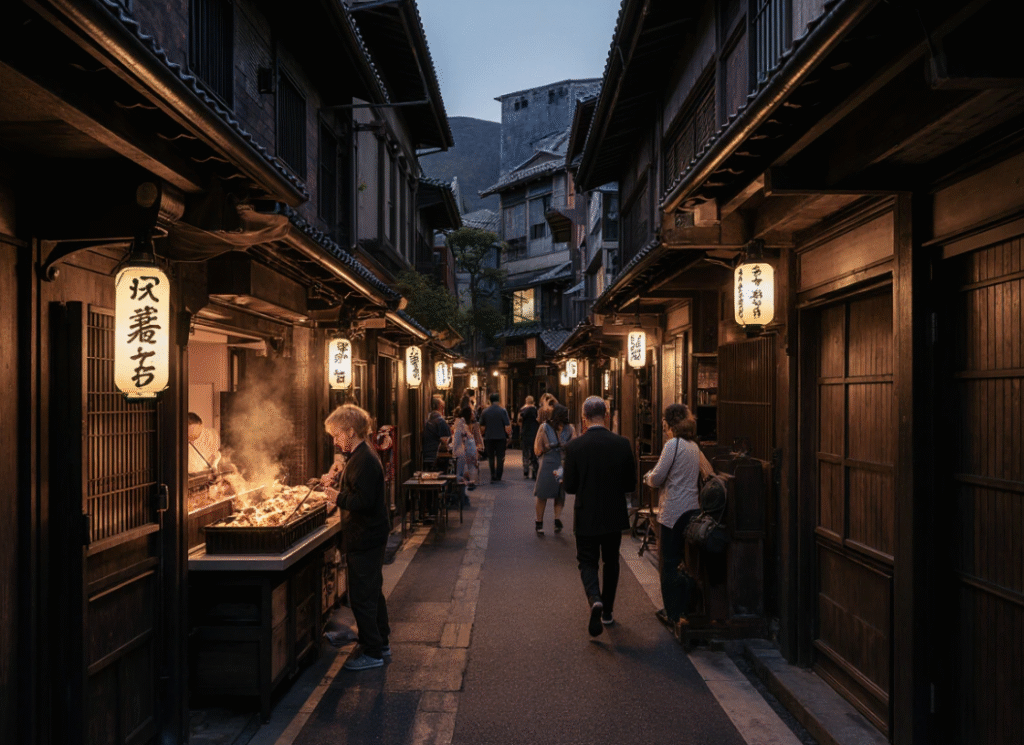
Best Yakitori Pontocho – Enjoy Traditional Yakitori in Kyoto’s Iconic Alley
Sake works but requires more thought. The tare sauce already has sake in it, so you want something that doesn’t duplicate flavors. Ask for karakuchi (dry) sake served cold. Avoid the sweet varieties.
Avoid wine. The tannins in red wine clash with the tare sauce. White wine gets lost.
Understanding Pontocho’s Layout and Atmosphere
Pontocho runs north-south for 500 meters between Shijo Street and Sanjo Street. The alley is barely wide enough for two people to pass. Traditional wooden buildings lean in from both sides. Paper lanterns mark entrances.
Most yakitori shops occupy the ground floor of two-story machiya houses. Seating is limited—counters with 6-10 stools, or a few small tables. The kitchens are tiny. Everything happens in view.
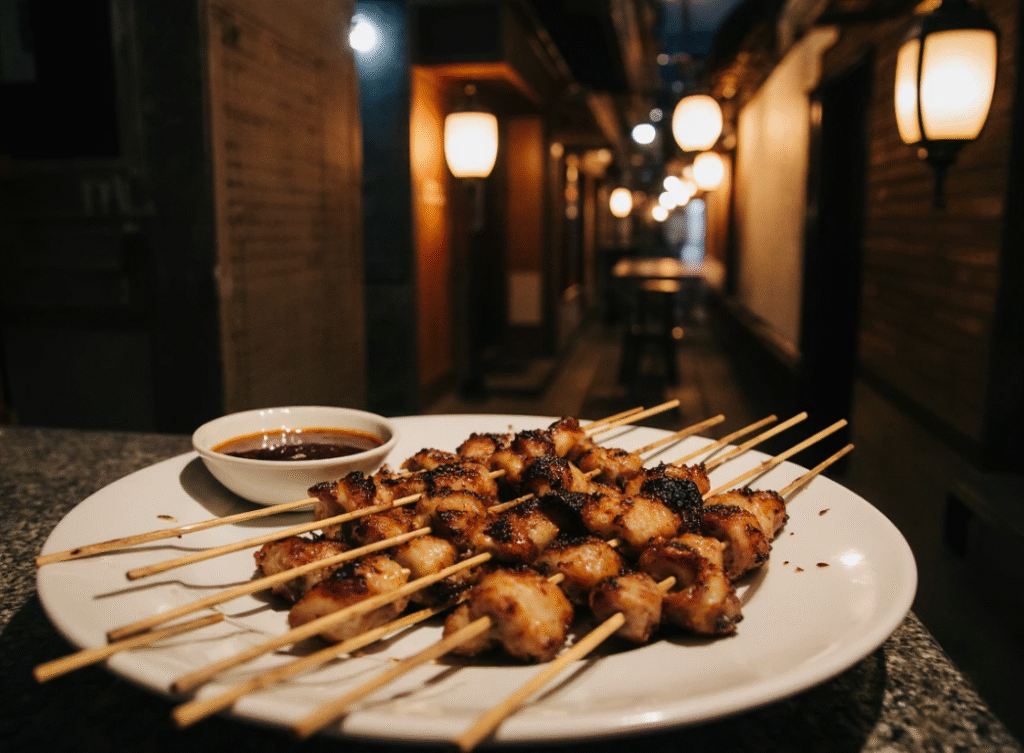
Best Yakitori Pontocho – Grilled Chicken Skewers with Traditional Kyoto Flavor
The atmosphere is informal but not casual. People dress normally—jeans are fine—but the attention to food is serious. Conversations happen in lowered voices. The focus stays on the grill.
Some places have river-facing seats on elevated platforms called yuka. These open in summer when the weather allows. The platforms extend over the Kamogawa River. You sit on cushions, eat yakitori, and watch the water flow below. It’s a premium experience that costs extra but transforms the meal into something ceremonial.
The Kyoto City Official Travel Guide notes that yuka dining platforms are typically available from May through September, weather permitting.
The Real Drawbacks of Pontocho Yakitori
- The alley is claustrophobic. If you’re uncomfortable in tight spaces, Pontocho will stress you out. People squeeze past each other constantly. Interiors are small. There’s no personal space buffer.
- It’s expensive for what you get. Yakitori in Tokyo costs 30-40% less for similar quality. You’re paying for the Pontocho location and atmosphere. If budget is your priority, other Kyoto neighborhoods offer better value.
- Service can be impersonal. The best spots are always busy. Chefs focus on grilling. They’re polite but not chatty. If you want an interactive dining experience with lots of explanations, some places will disappoint you.
- It’s not family-friendly. The yakitori shops are designed for adults having drinks after work. There are no high chairs. No kids’ menus. The spaces are too small for strollers. The atmosphere is too refined for children to enjoy.
These aren’t fixable problems. They’re inherent to what makes Pontocho Yakitori special—the historic buildings, the narrow lane, the adult-focused nightlife culture. If these factors matter to you, choose a different neighborhood.
Comparing Your Options: Budget Yakitori Kyoto
| Venue Type | Average Cost | Atmosphere | Best For |
| Yakitori-only specialists | ¥5,000-7,000 ($33-47) | Quiet, focused counter seating | Solo diners, serious food enthusiasts |
| Mixed robata grill | ¥3,500-5,000 ($23-33) | More casual, table seating available | Groups, people wanting variety |
| Yuka (river platform) dining | ¥8,000-12,000 ($53-80) | Premium, romantic outdoor setting | Special occasions, couples |
For those seeking budget Yakitori Kyoto options, the mixed robata grill venues offer the most value. They provide authentic charcoal-grilled chicken at lower prices while maintaining quality standards.
Timing Your Visit to Pontocho
Summer (June-September) is when the yuka platforms open. The weather is hot and humid, but eating above the river while the sun sets makes up for the discomfort. Reservations are essential during this season.
Winter (December-February) is less crowded but cold. The narrow alley doesn’t trap much heat. Some shops have kotatsu (heated tables), but most don’t. Dress warmly.
Spring and fall are optimal. Comfortable temperatures. Cherry blossoms in April or autumn leaves in November add visual appeal. But these are also peak tourist seasons, so crowds increase.
“Visit Pontocho twice—once in the early evening to walk the alley before it gets crowded, then return at 5:30 PM to eat. Take photos during your first pass when the light is better and the lane isn’t packed with people. Then you can focus on food during your actual meal without rushing.”
How to Navigate Best Yakitori Pontocho Like a Local
Walk slowly down the entire alley before choosing where to eat. Check the displays outside—most places show plastic food models or photos of their dishes. Look at prices. Observe the crowd inside.
Avoid venues with aggressive touts outside. If someone is pulling people in, the food probably isn’t good enough to attract customers naturally.
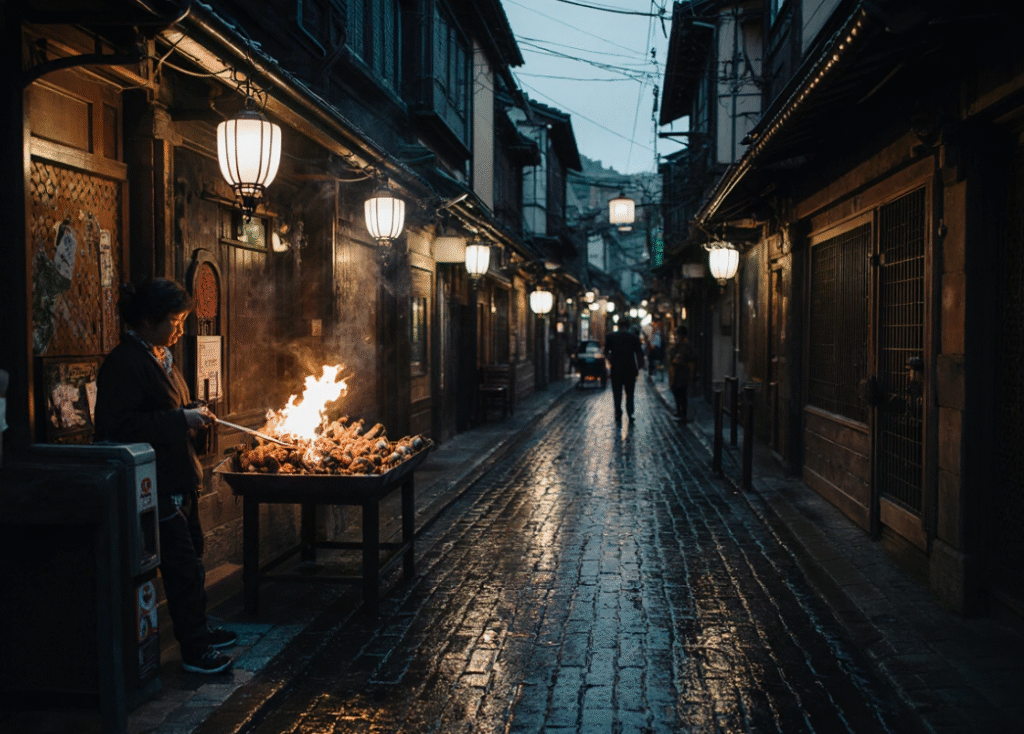
Pontocho Chicken Skewers – Authentic Yakitori Experience in Kyoto’s Historic Alley
Look for spots where locals are eating. If the counter has several Japanese businessmen who clearly aren’t tourists, that’s a reliable signal.
Don’t be intimidated by Japanese-only menus. Point at what other diners are eating. Say “kore o kudasai” (I’ll have that). Most chefs appreciate the gesture and will help you order.
The alley is one-way for foot traffic during peak hours. Enter from Shijo Street, exit at Sanjo Street. Going against the flow is possible but awkward.
Behind the Curtain: What Most Guides Don’t Tell You
The chickens used in high-end Pontocho Yakitori shops are typically jidori—a term meaning heritage breed chickens raised with specific standards. These birds are at least 80 days old when slaughtered (industrial chickens are 50-55 days). They cost three times more than regular chicken.
Many Pontocho chefs apprenticed for 8-10 years before opening their own establishments. The training includes learning to break down whole chickens with minimal waste, prepare each cut properly, and master the grill. A seemingly simple job requires intense dedication.
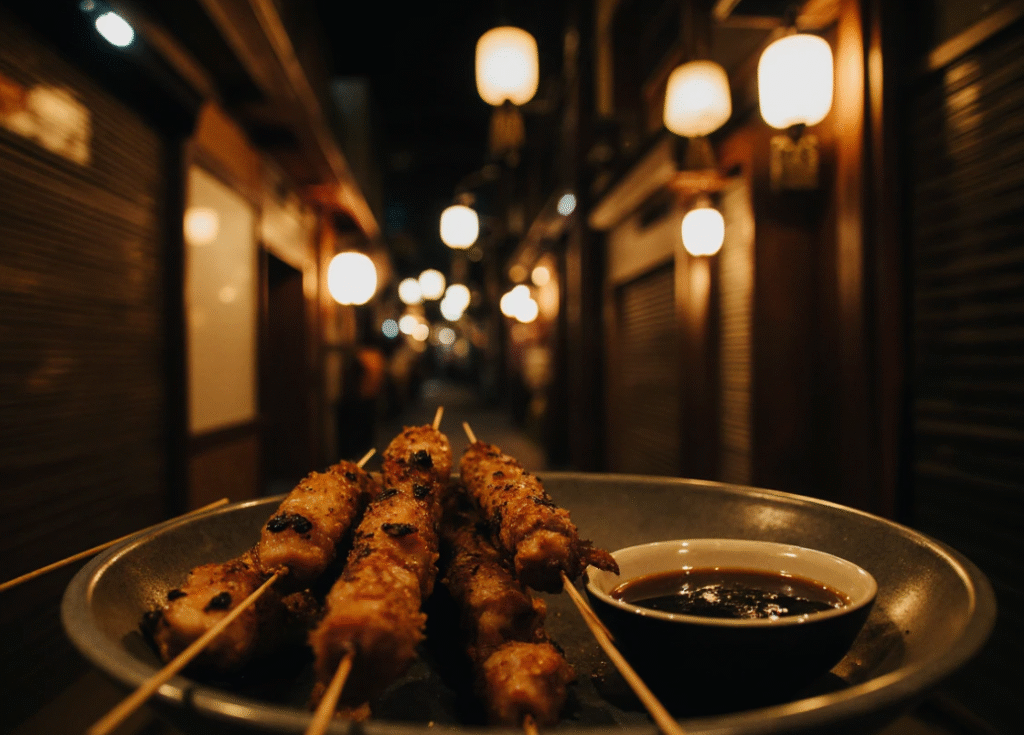
The tare sauce in each shop is decades old. Chefs continuously add new sauce to the pot but never empty it completely. Some tare bases have been maintained for 40+ years. The aged sauce develops complex flavors impossible to replicate with fresh ingredients.
Some establishments follow guidelines similar to those outlined by the Japan Yakitori Association, which promotes traditional grilling techniques and quality standards across the country.
Making the Most of Your Pontocho Yakitori Experience
Pontocho works best as part of a larger evening in Kyoto. Eat yakitori, then walk along the Kamogawa River. Or start with drinks in Pontocho, then move to nearby Gion for dessert.
Don’t try to rush the experience. Pontocho Yakitori is designed for slow eating and drinking. Budget 90 minutes minimum.
Learn basic Japanese phrases:
- “Oishii” (delicious) – use this after eating something you like
- “Okawari” (one more) – when you want to order the same skewer again
- “Oaiso onegaishimasu” (check please) – when you’re ready to leave
Staff appreciate the effort even if your pronunciation is terrible.
Consider visiting on a weeknight instead of Friday or Saturday. The quality is identical, but the crowds thin out significantly. A Tuesday or Wednesday evening gives you more options and shorter wait times.
If you’re traveling with someone who doesn’t eat chicken, Pontocho has other options—tempura, sushi, kaiseki. But finding the best Yakitori Pontocho has to offer remains the alley’s primary draw. Choose accordingly.
